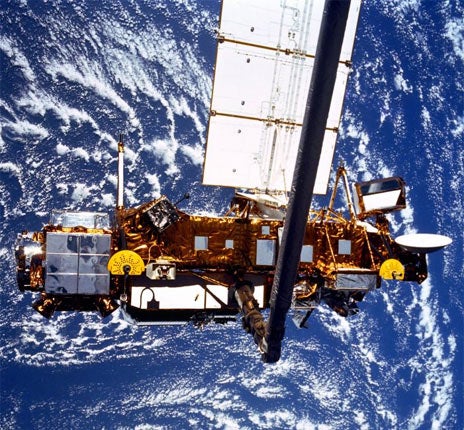Satellite heading for Earth (but the odds of survival are in your favour)

Your support helps us to tell the story
From reproductive rights to climate change to Big Tech, The Independent is on the ground when the story is developing. Whether it's investigating the financials of Elon Musk's pro-Trump PAC or producing our latest documentary, 'The A Word', which shines a light on the American women fighting for reproductive rights, we know how important it is to parse out the facts from the messaging.
At such a critical moment in US history, we need reporters on the ground. Your donation allows us to keep sending journalists to speak to both sides of the story.
The Independent is trusted by Americans across the entire political spectrum. And unlike many other quality news outlets, we choose not to lock Americans out of our reporting and analysis with paywalls. We believe quality journalism should be available to everyone, paid for by those who can afford it.
Your support makes all the difference.The chances may be extremely slim of anyone being struck by the remnants of a six-tonne US satellite expected to crash to Earth today, but there is at least one precedent for such an unfortunate occurrence.
On 22 January 1997, Lottie Williams of Tulsa, Oklahoma, became (and remains) the only person ever to have been hit by falling space junk. She was out walking with friends when a 6cm piece of metal just glanced off her shoulder. It was a remnant of a Nasa Delta rocket falling back to Earth after a launch some months earlier. She told the Toronto Sun: "It looked like burnt trash. If you ever see something like that, you're in awe of it."
The latest falling space "trash", thankfully, is more likely to face a watery grave than hit land. The Nasa climate research satellite is due to plummet through the atmosphere this evening, British time. It is not known where the wreckage is likely to land, although this should become clearer during the day.
So far, Nasa officials will say only that it will not be travelling over North America. "It is still too early to predict the time and location of re-entry with any more certainty," Nasa said. The 20-year-old Upper Atmosphere Research Satellite has gained attention because it will be the biggest Nasa spacecraft to fall uncontrolled from the sky in 32 years. Most fragments will burn up but it is estimated that 26 pieces, weighing a total of about 530kg (1,200lb) will survive re-entry and be scattered along a 250-mile (400km) path– not that people need to take cover.
Nasa expects a splashdown rather than a landing because nearly three-quarters of the world's surface is water. It puts the chances that somebody somewhere will get hurt by a falling chunk of debris at 1 in 3,200 – which means that, for any individual, the chances are in the trillions to one.
As far as anyone knows, space debris has never hurt anyone, although Lottie Williams would probably not wish to repeat the experience any time soon.
The satellite by numbers
21,000 Pieces of space junk orbiting earth that are bigger than 10 centimetres across.
310 Upper estimate of the length, in miles, of the area that debris from the satellite will fall across.
21 trillion/1 The chances of being hit by a fragment of satellite.
Join our commenting forum
Join thought-provoking conversations, follow other Independent readers and see their replies
Comments